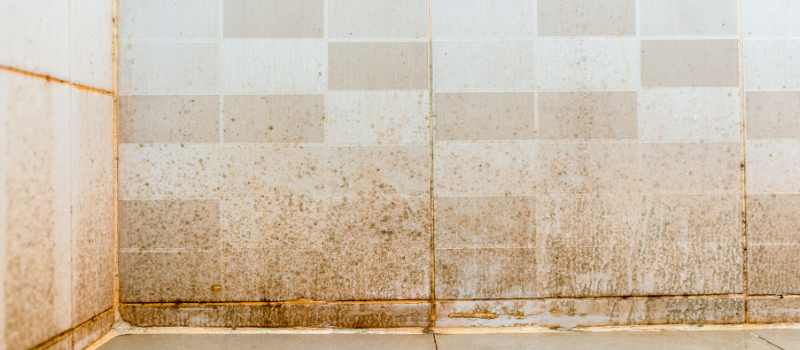Many mistake this pink slimy substance for mold, it's not. It will appears as pink or orange. It's nasty bacteria and it's gross.
Believe it or not, the pink substance you often encounter in your shower isn't actually mold. The pink residue that commonly appears on your shower floor, grout, near the water line of your toilet, and even on the bottom of your shower curtain is, in fact, a variety of airborne bacteria known as Serratia marcescens.
This bacteria has a knack for popping up in bathroom settings due to its preference for damp environments, where it flourishes by feeding on fat and mineral deposits left behind by soap scum and shampoo. While Serratia marcescens is generally harmless and won't cause any issues through casual contact, however, it can lead to infections if it enters open wounds or the eyes, it is certainly unsightly and unwanted in your bathroom. Here's how you can effectively eliminate this "pink mold" from your bathroom:
Shower Curtain & Liner:
- Prepare a solution by mixing equal parts of bleach and water in a spray bottle. For colorful curtains, opt for a color-safe cleaner like OxiClean.
- Spray this solution onto any pink spots on your shower curtain and liner.
- Allow it to sit for 10 minutes, then remove both the curtain and liner, and run them through a washing machine cycle using the recommended washing guide. Use your regular laundry detergent, and if your curtain is white, add an extra tablespoon of bleach. If you have a color, or it have stitching avoid using bleach.
- Hang the curtain and liner to dry.
Shower Walls & Doors: Before starting remove all objects from your shower or tub.
- Create a cleaning paste by combining 1/4 cup of baking soda with 1 tablespoon of liquid dish soap.
- Apply this paste to the areas affected by the pink film using a soft bristle brush, then scrub away the residue.
- Rinse the area thoroughly.
- Once the pink film is gone, disinfect the area by filling a spray bottle with a 1:1 mixture of bleach and water. Spray the contaminated area, let it sit for 10 minutes, and then rinse.
- Dry the area with a towel or squeegee.
Tile & Grout:
You can clean tile, grout, and any hard, bleach-safe surfaces using the same method as for shower walls and doors: scrub with the baking soda paste and then disinfect with the bleach mixture.
If you have natural stone tile, remember that while the bleach and water mixture is safe for occasional use, its high pH level can gradually damage natural stone. To protect natural stone, regularly seal it and keep it clean and dry to minimize the need for bleach.
Prevention:
To prevent the growth of pink mold (Serratia marcescens) in your bathroom, follow these steps:
Regular Cleaning: Keep your bathroom clean and dry. Regularly clean all surfaces, including shower walls, curtains, tiles, grout, and any areas prone to moisture buildup. Use a bathroom cleaner that targets mold and mildew.
Ventilation: Ensure proper ventilation in your bathroom. Use exhaust fans or open windows during and after showers to reduce humidity and moisture levels. Proper ventilation helps create an environment less conducive to mold growth.
Dry Surfaces: After using the shower or bath, wipe down wet surfaces with a towel or squeegee. Pay attention to areas like the shower curtain, walls, and tiles. Removing excess moisture prevents mold from thriving.
Fix Leaks: Promptly address any leaks in your bathroom, including faucets, pipes, or the showerhead. Leaks create damp conditions that encourage mold growth.
Seal Grout: If your bathroom has tile and grout, consider sealing the grout lines. This will make them less porous and less likely to absorb moisture and mold spores.
Use Mildew-Resistant Products: Use bathroom products like shower curtains, liners, and bath mats that are labeled as mildew-resistant or antimicrobial. These products are designed to resist mold growth.
Avoid Overusing Bleach: While bleach can be effective against mold, it should be used sparingly on porous surfaces like grout, as it can deteriorate them over time. Opt for alternative mold cleaning products when possible.
Regular Maintenance: Periodically inspect your bathroom for any signs of mold or pink residue. If you notice any, clean it promptly to prevent further growth.
Reduce Clutter: Minimize clutter in your bathroom, as it can trap moisture and make it harder to clean and prevent mold.
Natural Alternatives: Consider using natural mold prevention methods such as vinegar and hydrogen peroxide solutions, which can help keep mold at bay without the harsh chemicals found in some commercial cleaners.
By following these preventive measures and maintaining a clean, dry bathroom environment, you can significantly reduce the chances of pink mold (Serratia marcescens) growth in your bathroom.
It's crucial to be aware of the potential dangers when mixing chemicals. Even everyday household items like drain cleaners can create harmful vapors if combined. Before starting, ensure that your drains are free from any previous chemical residues.
Additionally, it's important to recognize that prolonged use of bleach on porous surfaces, such as grout, can lead to its deterioration, causing it to weaken and eventually break apart. Therefore, it's advisable to use bleach sparingly, preferably for deep cleaning purposes only. After using bleach, thoroughly rinse and then dry the surface.
If you found this helpful share with others.










